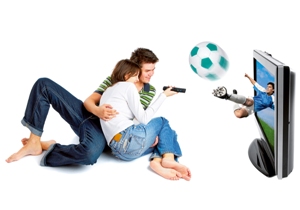Aug 3 2013
3D movies have become commonplace over the last while. The black plastic stereo viewing glasses are even piling up at home. Good that glasses-free video displays for home use have become available. However, the technology is still not mature or widespread, and televisions of this kind are still too expensive. Researchers are working on solutions to change that.
 A new image processing technique automatically calculates where the viewer is located in front of the television. The user can move about more freely in the room without wearing 3D stereo viewing glasses as well. © Fraunhofer HHI
A new image processing technique automatically calculates where the viewer is located in front of the television. The user can move about more freely in the room without wearing 3D stereo viewing glasses as well. © Fraunhofer HHI
Thanks to a new image processing technique, we can now move about in a room more freely when watching 3D-TV without wearing stereo viewing glasses. Fraunhofer will be exhibiting the technology at the IFA international consumer electronics trade fair (Internationale Funkausstellung) in Berlin September 6 – 11, 2013.
In order to dispense with 3D glasses, a television needs to have information about the exact eye position of the viewer. Built-in cameras need to track both pupils continuously to obtain this information. Each eye perceives a separate image so that the 3D effect appears without using the glasses. Nevertheless, the technology still has its weaknesses. If the user moves too quickly or changes viewing position, the images appear distorted or unstable. The manufacturers prescribe optimal viewing distances that are supposed to guaranty quality viewing. Purchasers of autostereoscopic television models today, i.e. 3D models not requiring stereo viewing glasses to be worn, are confronted not just with a high price tag, they also have to live with loss of depth and image resolution once the distance to the screen falls below or exceeds the recommended one.
The image adapts to the position of the user
Help has now arrived from the labs of the Fraunhofer Institute for Telecommunications, Heinrich Hertz Institute (HHI), in Berlin. Researchers have developed a new image processing technique that enables viewers to enjoy full 3D quality, even at different distances – and without having to wear stereo viewing glasses. As a result, viewing can be enjoyed at as little as half or up to twice the originally specified viewing distance. The trick: while software cannot eliminate image distortion, it can nevertheless shift it so that viewers always have an undistorted 3D image before their eyes. Even if a viewer moves from the initially specified position. This results from re-calculating the individual sub-pixels for the display by means of a mathematical algorithm whenever the viewer changes position. This way, images are formed that are located between the left and right eyes and are available as additional viewing points. The viewer can move not only forwards and backwards, but sideways as well, without distorted images being formed or images jumping back and forth between individual 3D views.
“Until now, this could only be accomplished by a very expensive mechanical means. The new digital processing works faster and more robustly. In developing the electronic version, we benefitted from technological progress in image resolution and image processing software,” explains Klaus Hopf, HHI Group Manager for „Man-Machine Interaction“. The new technology has been optimized for multiview 3D displays. This kind of display is able to provide several different viewing points so that several users can experience the effect without wearing stereo viewing glasses. The new technique now permits up to five persons to view 3D content at a distance of 30 cm (12 in) to six meters (20 ft) without impairing the apparent depth and image resolution. The freedom of movement attained enables viewing autostereoscopic displays on desktops, watching television or viewing displays in public spaces.
Researchers will be exhibiting the technology in the Fraunhofer Booth at the IFA
“Glasses-free 3D systems are currently beginning to be used in medicine, research, and industrial applications. The new software can also provide new impetus for introducing the technology into the home or in advertising,” predicts Hopf. He will be exhibiting the new technique in the Fraunhofer Booth at the IFA (IFA TecWatch, Hall 11.1, Booth 21).